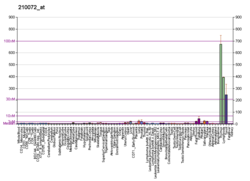Top Qs
Timeline
Chat
Perspective
CCL19
Mammalian protein found in humans From Wikipedia, the free encyclopedia
Remove ads
Chemokine (C-C motif) ligand 19 (CCL19) is a protein that in humans is encoded by the CCL19 gene.[5][6]
This gene is one of several CC cytokine genes clustered on the p-arm of chromosome 9. Cytokines are a family of secreted proteins involved in immunoregulatory and inflammatory processes. The CC cytokines are proteins characterized by two adjacent cysteines. The cytokine encoded by this gene may play a role in normal lymphocyte recirculation and homing. It also plays an important role in trafficking of T cells in thymus, and in T cell and B cell migration to secondary lymphoid organs. It specifically binds to chemokine receptor CCR7.[6]
Chemokine (C-C motif) ligand 19 (CCL19) is a small cytokine belonging to the CC chemokine family that is also known as EBI1 ligand chemokine (ELC) and macrophage inflammatory protein-3-beta (MIP-3-beta). CCL19 is expressed abundantly in thymus and lymph nodes, with moderate levels in trachea and colon and low levels in stomach, small intestine, lung, kidney and spleen.[7] The gene for CCL19 is located on human chromosome 9.[8] This chemokine elicits its effects on its target cells by binding to the chemokine receptor chemokine receptor CCR7.[7] It attracts certain cells of the immune system, including dendritic cells and antigen-engaged B cells,[9][10] CCR7+ central-memory T-Cells.[11]
Remove ads
References
Further reading
External links
Wikiwand - on
Seamless Wikipedia browsing. On steroids.
Remove ads





